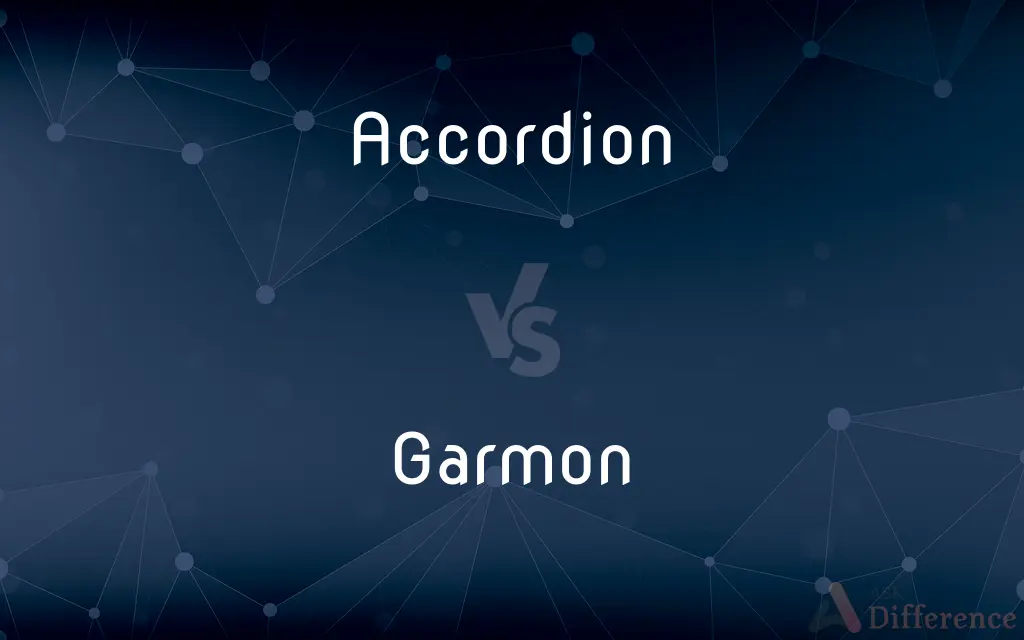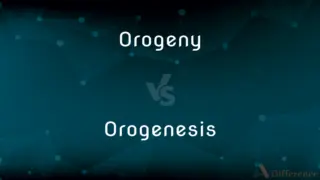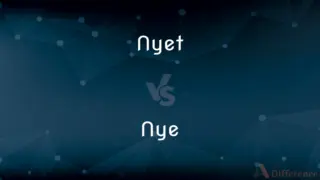Accordion vs. Garmon — What's the Difference?
By Tayyaba Rehman & Urooj Arif — Updated on April 29, 2024
Accordion typically features piano-style keys or buttons for melody, while Garmon, a type of button accordion, is smaller and uses diatonic buttons, popular in Eastern European folk music.

Difference Between Accordion and Garmon
Table of Contents
ADVERTISEMENT
Key Differences
The accordion is a versatile instrument known for its piano-style or chromatic button keyboards that control melody. On the other hand, the Garmon is distinguished by its diatonic button system, which is specifically designed to play a limited range of notes, aligning with its regional folk music traditions.
Accordions often have a range of bass buttons that enable the player to accompany themselves with complex basslines. Whereas the Garmon usually features fewer bass capabilities, focusing more on melody to suit its traditional music styles.
The size and portability of the accordion can vary, with some larger models designed for concert performances. Conversely, the Garmon is generally more compact and portable, making it ideal for mobile performances like street festivals and dances.
In terms of construction, accordions can have multiple reeds per note, allowing for a richer and more versatile sound production. In contrast, the Garmon typically has a simpler setup with fewer reeds, which produces a brighter, more piercing sound characteristic of its folk origins.
The accordion is widely used across various genres of music worldwide, from classical to folk to modern pop. On the other hand, the Garmon holds a special place in Eastern European music, particularly in Russian and Ukrainian folklore, where it remains a cultural symbol.
ADVERTISEMENT
Comparison Chart
Keys
Piano-style or chromatic button keys
Diatonic button keys
Size
Ranges from medium to large
Generally smaller and more portable
Sound Production
Multiple reeds per note for richness
Fewer reeds, produces a brighter sound
Bass Capabilities
Extensive bass buttons for accompaniment
Limited bass features, focuses on melody
Usage
Versatile across many music genres
Predominantly used in Eastern European folk
Compare with Definitions
Accordion
Suitable for a wide range of musical genres.
From polka to jazz, the accordion shines in diverse musical styles.
Garmon
Primarily used in folk music settings.
Garmon is a staple in Russian and Ukrainian folk bands.
Accordion
Can be used solo or in ensemble settings.
Accordion is popular in both solo performances and orchestral arrangements.
Garmon
A small, diatonic button accordion popular in Eastern Europe.
He played traditional songs on his Garmon at the festival.
Accordion
A musical instrument played by stretching and squeezing with hands to work a bellows.
The musician impressed the audience with a complex piece on the accordion.
Garmon
Lacks the range of keys found on larger accordions.
The Garmon’s limited keys influence its unique sound.
Accordion
Often large and intricate, requiring skilled playing.
Mastering the accordion takes years of dedicated practice.
Garmon
Portable and suited for mobile performances.
The musician carried his Garmon easily throughout the parade.
Accordion
Equipped with a keyboard or buttons for melody and bass.
She chose an accordion with piano keys for its musical versatility.
Garmon
Symbolic in regional cultural expressions.
In his music, the Garmon evokes a strong sense of Eastern European identity.
Accordion
Accordions (from 19th-century German Akkordeon, from Akkord—"musical chord, concord of sounds") are a family of box-shaped musical instruments of the bellows-driven free-reed aerophone type, colloquially referred to as a squeezebox. A person who plays the accordion is called an accordionist.
Garmon
The garmon (Russian: гармо́нь, IPA: [gɐˈrmonʲ], (commonly, garmoshka), from garmonika (Russian: гармо́ника, IPA: [gɐˈrmonʲɪkə]), which means "harmonicа"), is a kind of Russian button accordion, a free-reed wind instrument. A garmon has two rows of buttons on the right side, which play the notes of a diatonic scale, and at least two rows of buttons on the left side, which play the primary chords in the key of the instrument as well as its relative harmonic minor key.
Accordion
A musical instrument played by stretching and squeezing with the hands to work a central bellows that blows air over metal reeds, the melody and chords being sounded by buttons or keys.
Her five brothers and sisters were singing to the accompaniment of an accordion
An accordion player
Garmon
A kind of smaller Russian button accordion.
Accordion
A portable wind instrument with a small keyboard and free metal reeds that sound when air is forced past them by pleated bellows operated by the player.
Accordion
Having folds or bends like the bellows of an accordion
Accordion pleats.
Accordion blinds.
Accordion
A box-shaped musical instrument with means of keys and buttons, whose tones are generated by play of the wind from a squeezed bellows upon free metallic reeds.
Accordion
(GUI) A vertical list of items that can be individually expanded and collapsed to reveal their contents.
Accordion
(figurative) A set of items (concepts, links, or otherwise) that can be packed and unpacked cognitively, or their representation as a set of virtual object. en
Accordion
To fold up, in the manner of an accordion
Accordion
A small, portable, keyed wind instrument, whose tones are generated by play of the wind upon free metallic reeds.
Accordion
A portable box-shaped free-reed instrument; the reeds are made to vibrate by air from the bellows controlled by the player
Accordion
Arranged in parallel folds;
Plicate leaves
Common Curiosities
What is a Garmon?
A Garmon is a type of button accordion, smaller, with diatonic buttons, primarily used in Eastern European folk music.
Are the playing techniques for accordion and Garmon similar?
While both instruments use a similar bellows technique, their key layouts differ significantly, influencing playing styles and repertoire.
What is an accordion?
An accordion is a musical instrument with a bellows and keys or buttons for playing melody and bass, known for its versatility in various music genres.
Which instrument is more portable, accordion or Garmon?
The Garmon is generally more portable due to its smaller size compared to many accordions.
What types of music are best suited for the accordion?
The accordion is suited for a broad range of music from classical and folk to modern pop and jazz.
How does the sound of an accordion differ from a Garmon?
An accordion typically produces a richer, more versatile sound due to multiple reeds per note, while a Garmon's sound is brighter and more piercing.
What types of music are best suited for the Garmon?
The Garmon excels in traditional Eastern European folk music, where it plays a central role.
Which instrument is easier to learn for beginners?
The Garmon might be easier due to its simpler button layout and smaller size, making it less intimidating for beginners.
Can both the accordion and Garmon be used in folk music?
Yes, both can be used in folk music, though the accordion is more versatile globally, while the Garmon is specifically cherished in Eastern European folk traditions.
How do the construction features of the accordion and Garmon influence their sound?
The accordion's multiple reeds per note allow for a fuller sound, while the Garmon's fewer reeds produce a distinctively sharp tone.
Is the accordion more culturally versatile than the Garmon?
Yes, the accordion is used globally across various cultures and music styles, whereas the Garmon is more regionally specific to Eastern Europe.
How do the bass capabilities of the accordion and Garmon compare?
Accordions often have extensive bass capabilities allowing for complex accompaniment, while Garmon focuses more on melody with limited bass options.
Share Your Discovery

Previous Comparison
Orogeny vs. Orogenesis
Next Comparison
Nyet vs. NyeAuthor Spotlight
Written by
Tayyaba RehmanTayyaba Rehman is a distinguished writer, currently serving as a primary contributor to askdifference.com. As a researcher in semantics and etymology, Tayyaba's passion for the complexity of languages and their distinctions has found a perfect home on the platform. Tayyaba delves into the intricacies of language, distinguishing between commonly confused words and phrases, thereby providing clarity for readers worldwide.
Co-written by
Urooj ArifUrooj is a skilled content writer at Ask Difference, known for her exceptional ability to simplify complex topics into engaging and informative content. With a passion for research and a flair for clear, concise writing, she consistently delivers articles that resonate with our diverse audience.














































